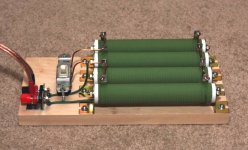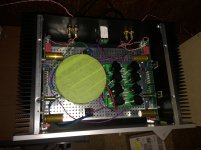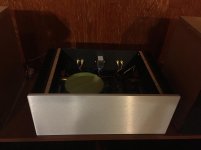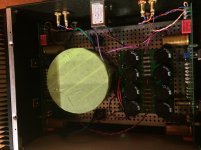Pass DIY Addict
Joined 2000
Paid Member
Another good dummy load 16R 120w: 16 Ohm 120W Power Resistor | MPJA.COM
Stack them in parallel, two for 8R at 240w, four for 4R load at 480w, put a switch in the middle as shown. They turn a little yellow as you get them hot enough to singe your fingers...
Stack them in parallel, two for 8R at 240w, four for 4R load at 480w, put a switch in the middle as shown. They turn a little yellow as you get them hot enough to singe your fingers...
Attachments
Last edited:
Pass DIY Addict
Joined 2000
Paid Member
I never measured them for inductance. I'll have to pull out my meter tonight to see how they measure...
ERIC , it is a wirewound resistor not sure it will have zero inductance. But I am no expert.
Does it really matter if dummy load resistor has a tiny amount of inductance?
I don’t know how to define tiny since I don’t know what is considered normal. I was reading the idea was to simulate a pure resistive load so zero inductance is the goal. Is it possible in real life .. not sure!
So I went with what claims as non inductive from parts express.
So I went with what claims as non inductive from parts express.
Pass DIY Addict
Joined 2000
Paid Member
I don't know how to define "tiny" either, so I made some comparisons with my LCR meter at both 120Hz and 1kHz for a few speakers and for my dummy load resistors. Here are the results:
Avro Open Baffle Speakers: 3.8mH (120Hz) and 262uH (1kHz)
Atlantic Tech 350 THX Speakers: 0.49mH (120Hz) and 58uH (1kHz)
FHXL w/ 10.3 Metal drivers: 6.9mH (120Hz) and 512uH (1kHz)
Tang Band 1772 speakers: 7.1mH (120Hz) and 421uH (1kHz)
----------------
Dummy Load 8R: 0.01mH (120Hz) and 4.2uH (1kHz)
Dummy Load 4R: 0.01mH (120Hz) and 2.6uH (1kHz)
I'm thinking these resistors qualify as "non-inductive." They are on the order of 1/100th of the inductance that real speakers present to an amplifier. They're good enough for me!
Avro Open Baffle Speakers: 3.8mH (120Hz) and 262uH (1kHz)
Atlantic Tech 350 THX Speakers: 0.49mH (120Hz) and 58uH (1kHz)
FHXL w/ 10.3 Metal drivers: 6.9mH (120Hz) and 512uH (1kHz)
Tang Band 1772 speakers: 7.1mH (120Hz) and 421uH (1kHz)
----------------
Dummy Load 8R: 0.01mH (120Hz) and 4.2uH (1kHz)
Dummy Load 4R: 0.01mH (120Hz) and 2.6uH (1kHz)
I'm thinking these resistors qualify as "non-inductive." They are on the order of 1/100th of the inductance that real speakers present to an amplifier. They're good enough for me!
> Dummy Load 8R: 0.01mH (120Hz) and 4.2uH (1kHz)
If 4.2uH is true at 20KHz, then it amounts to another 0.5 Ohms of load impedance.
If you have to meet a Government Specification with 1% precision, a 6% increase of load makes your number-claims dubious.
As you say, with any dynamic loudspeaker (even speaker cables), this is "no inductance at all". If it shaves your 20KHz THD a sliver, this is arguably more real-world than the Ideal Resistor.
Besides which, the MPJA price is far lower.....
If 4.2uH is true at 20KHz, then it amounts to another 0.5 Ohms of load impedance.
If you have to meet a Government Specification with 1% precision, a 6% increase of load makes your number-claims dubious.
As you say, with any dynamic loudspeaker (even speaker cables), this is "no inductance at all". If it shaves your 20KHz THD a sliver, this is arguably more real-world than the Ideal Resistor.
Besides which, the MPJA price is far lower.....
I never measured them for inductance. I'll have to pull out my meter tonight to see how they measure...
@ Eric
Could be possible for You measure inductance of the same value and power rate of metal films resistors
for compare with wire wounds how much is difference ?
Inductive metal films ?
Greetings 🙂
Pass DIY Addict
Joined 2000
Paid Member
PRR: There are probably more precise means for making such measurements, I just connected my LCR meter and toggled between the two frequency-based readings that it provides. I confess to not understanding the mechanism by which you converted my measurement to an additional resistance rating at 20kHz...
Soundhappy: I'm sorry to say that I don't have an equivalent set of metal film resistors in order to conduct a comparison...
Overall, my points are: 1) the inductance of these resistors (even 4 in parallel) is clearly dwarfed by the inductance present in real speakers, and 2) there are alternate sources that are more cost effective.
Soundhappy: I'm sorry to say that I don't have an equivalent set of metal film resistors in order to conduct a comparison...
Overall, my points are: 1) the inductance of these resistors (even 4 in parallel) is clearly dwarfed by the inductance present in real speakers, and 2) there are alternate sources that are more cost effective.
Soundhappy: I'm sorry to say that I don't have an equivalent set of metal film resistors in order to conduct a comparison...
Ok Thank You Eric
I know this device is dissipating about ~35w in this design but can it be reliably used at much greater dissipation on a big heatsink ? I am asking this partialy because I thought silicon carbide could withstand a much higher temperature ?
Pass DIY Addict
Joined 2000
Paid Member
- Home
- Amplifiers
- Pass Labs
- F2J clone Build thread




